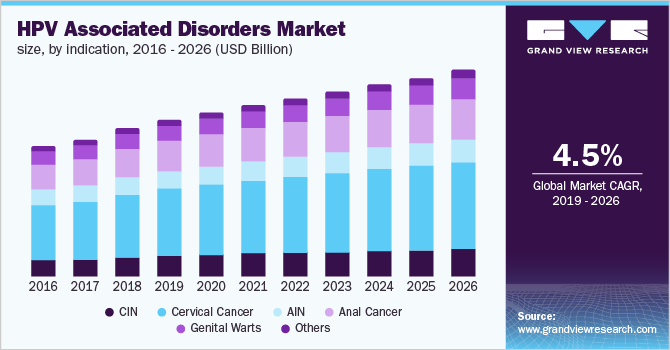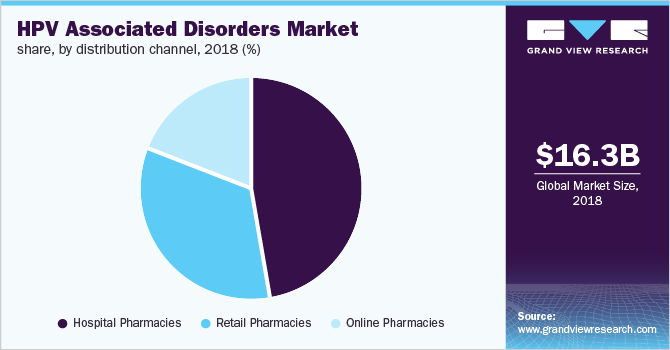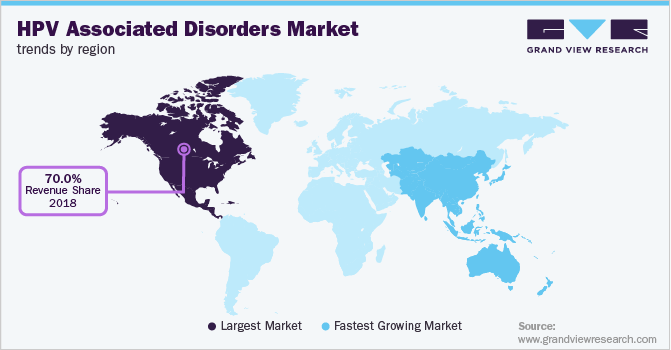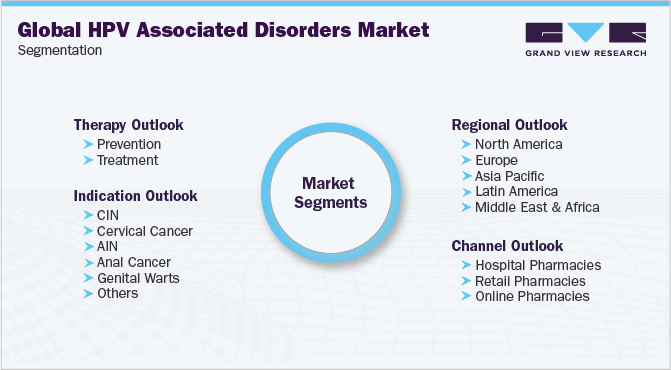- Home
- »
- Pharmaceuticals
- »
-
HPV Associated Disorders Market Size Report, 2030GVR Report cover
![HPV Associated Disorders Market Size, Share & Trends Report]()
HPV Associated Disorders Market Size, Share & Trends Analysis Report By Type (CIN, Cervical Cancer, AIN, Anal Cancer, Genital Warts), By Treatment, By Distribution Channel, By Region, And Segment Forecasts, 2024 - 2030
- Report ID: GVR-3-68038-436-9
- Number of Report Pages: 100
- Format: PDF, Horizon Databook
- Historical Range: 2018 - 2022
- Forecast Period: 2024 - 2030
- Industry: Healthcare
Report Overview
The global HPV associated disorders market size was estimated at USD 17.6 billion in 2023 and is projected to grow at a compound annual growth rate (CAGR) of 4.9% from 2024 to 2030. The WHO highlights HPV as one of the most common sexually transmitted infections, leading to serious health issues that require effective treatments and preventive measures. Growing global demand for solutions to HPV-associated disorders is fueling market expansion worldwide.

Advancements in treatment options are also crucial in driving market growth. The emergence of novel therapies and treatment options, including vaccines such as Gardasil and therapeutic agents, enhances patient outcomes and increases demand. Furthermore, government initiatives and healthcare investments support market growth by promoting vaccination programs and funding for cancer research. For instance, the Affordable Care Act in the U.S. promotes HPV vaccination, contributing to increased awareness and accessibility.
Rising healthcare expenditure is another key driver of the market. Increased spending on healthcare infrastructure, particularly in developing regions, is creating new opportunities for market growth. Enhanced healthcare systems facilitate better diagnosis and treatment availability, further driving market expansion. Moreover, consumer awareness of HPV-related diseases is growing, leading to higher vaccination rates and demand for screening services.
According to WHO data, in 2023, 14.5 million infants lacked initial DTP vaccination, highlighting access barriers to immunization and healthcare. 6.5 million others were partially vaccinated, with 60% of these children residing in 10 countries, primarily in Africa and Asia. Government initiatives and funding for cancer research are crucial drivers, as they enhance public health campaigns and increase vaccination rates and screening programs. This leads to early diagnosis and treatment, ultimately improving patient outcomes.
Type Insights
Cervical cancer led the market with a share of 34.7% in 2023, fueled by increased awareness of HPV’s role in the disease and government initiatives for vaccination and screening. Advances in diagnostic technologies and new therapies also contribute to market growth, with cervical cancer accounting for a significant share due to its prevalence and ongoing efforts to combat it.
The cervical intraepithelial neoplasia (CIN) segment is expected to grow at the fastest CAGR of 5.3% over the forecast period. Advancements in diagnostic methods, such as HPV DNA testing, enhance screening accuracy and facilitate early interventions. Government initiatives promoting HPV vaccination programs expand access to preventive measures, fueling market growth and solidifying CIN’s position as a key focal point in the fight against HPV-related diseases.
Treatment Insights
Vaccines dominated the market with a revenue share of 63.5% in 2023. Vaccines have demonstrated high efficacy in preventing HPV infections and cancers. The introduction of next-generation vaccines, such as Gardasil 9, which protects against nine HPV strains, has substantially influenced the market. Moreover, adolescent vaccination coverage is increasing, driven by initiatives such as the U.S. VFC program.
Anti-viral drugs are expected to register significant growth with CAGR of 4.9% over the forecast period, aided by the high prevalence of HPV infections and their link to various cancers. Recent advancements in antiviral agent development targeting HPV proteins show promise in inhibiting the virus and preventing disease progression. Innovative non-surgical options are needed to meet the growing demand for effective treatments.
Distribution Channel Insights
Hospital pharmacies held the largest revenue share of 48.8% in 2023. They maintain a robust inventory of HPV-related treatments, including vaccines and antivirals, ensuring timely availability for inpatients and outpatients. Growing demand for effective treatment options and increased consumer awareness are driving patients to hospital pharmacies, solidifying their position in the HPV treatment landscape.

Retail pharmacies are projected to grow at the fastest CAGR of 5.1% over the forecast period. Retail pharmacies offer patients convenience and accessibility through a comprehensive range of HPV-related products, including vaccines and treatments. With an expanding presence, especially in developing countries, retail pharmacies have increased access to HPV-related healthcare services. They also provide educational resources and counseling, enhancing patient awareness and understanding of HPV and its associated disorders.
Regional Insights
North America HPV associated disorders market dominated the global market with a revenue share of 37.7% in 2023. The region boasts strong biologics and high healthcare expenditures, enabling advanced treatment options and widespread vaccination programs. The presence of key manufacturers and government initiatives aimed at increasing awareness and access to HPV-related healthcare significantly contribute to market growth, driven by the rising incidence of HPV-associated cancers and the demand for effective interventions.

U.S. HPV Associated Disorders Market Trends
The HPV associated disorders market in U.S. dominated the North America market with a revenue share of 88.7% in 2023. Market growth in the country is driven by its advanced healthcare infrastructure and high spending. Leading pharmaceutical companies and innovative treatment options, including vaccines and antiviral therapies, ensure access to effective care. Government initiatives promoting HPV vaccination and awareness campaigns contribute significantly, while the rising incidence of HPV-related cancers and emphasis on preventive healthcare solidify the country’s presence in the global market.
Europe HPV Associated Disorders Market Trends
Europe HPV associated disorders market held substantial market share in 2023, driven by heightened awareness and screening programs for HPV-related diseases. A recent study by the European Cancer Organization revealed a concerning trend of high-risk HPV infection among European women, with rates exceeding 15% in certain countries. Healthcare systems are investing in advanced diagnostic technologies, enhancing early detection and treatment options. Government initiatives, rising cervical cancer incidence, and public-private collaborations are key factors driving market growth, fostering innovation and accessibility to effective therapies.
The HPV associated disorders market in Germany is poised for significant growth over the forecast period. Germany has implemented comprehensive screening programs and vaccination initiatives, increasing awareness about HPV-related diseases. Advances in diagnostic technologies improve early detection rates, facilitating timely interventions. Germany’s focus on pharmaceutical R&D fosters innovation in treatment options for HPV-associated disorders.
Asia Pacific HPV Associated Disorders Market Trends
Asia Pacific HPV associated disorders market is expected to register the fastest CAGR of 5.9% in the forecast period. Market growth in the region is propelled by rapid economic growth and improved healthcare infrastructure. Increasing disposable incomes have boosted access to HPV vaccines and treatments, driving higher vaccination rates. Rising HPV-related cancer incidence, particularly cervical cancer, has heightened awareness and demand for effective interventions, while government initiatives enhance immunization policies and drive market growth.
The HPV associated disorders market in China held a substantial market share in the Asia Pacific region in 2023. China’s rapid economic growth and improved healthcare access have made it a prominent player in Asia Pacific. The government’s prioritization of HPV vaccination programs has boosted awareness and uptake while rising disposable incomes drive demand for preventative care and treatments for HPV-related conditions.
Key Companies & Market Share Insights
Some key companies operating in the market include Merck & Co., Inc.; GlaxoSmithKline plc; F. Hoffmann-La Roche Ltd; among others. Competition in the market is intense, characterized by vaccine efficacy, distribution strategies, and ongoing research and development efforts.
-
GlaxoSmithKline offers a HPV vaccine Cervarix, approved in over 100 countries, demonstrates up to 93% effectiveness against cervical pre-cancers caused by HPV types 16 and 18, significantly contributing to global cervical cancer prevention efforts.
-
Roche offers cobas HPV Test detects high-risk HPV types in cervical samples, enabling early identification of women at risk for cervical cancer. This test is a critical component of screening programs and supports vaccination efforts by identifying individuals who require further clinical management.
Key HPV Associated Disorders Companies:
The following are the leading companies in the HPV associated disorders market. These companies collectively hold the largest market share and dictate industry trends.
- Merck & Co., Inc.
- GlaxoSmithKline plc
- GlaxoSmithKline plc
- Pfizer Inc.
- AstraZeneca
- Biocon
- Lilly
- AbbVie Inc.
Recent Developments
-
In September 2024, Pfizer showcased its diverse oncology portfolio and combination approaches at the ESMO Congress. Over 50 company-sponsored abstracts, including 10 oral and mini-oral presentations, highlighted promising early results and next-generation candidates.
-
In September 2024, Merck announced positive top-line results from a Phase 3 trial evaluating GARDASIL 9’s efficacy and safety in Japanese males, demonstrating a reduction in HPV-related anogenital persistent infections.
-
In May 2024, Roche announced the FDA approval of its HPV self-collection solution, expanding access to cervical cancer screenings and supporting the WHO’s goal of eliminating cervical cancer by 2030.
HPV Associated Disorders Market Report Scope
Report Attribute
Details
Market size value in 2024
USD 18.5 billion
Revenue forecast in 2030
USD 24.7 billion
Growth rate
CAGR of 4.9% from 2024 to 2030
Base year for estimation
2023
Historical data
2018 - 2022
Forecast period
2024 - 2030
Quantitative units
Revenue in USD million/billion and CAGR from 2024 to 2030
Report coverage
Revenue forecast, company ranking, competitive landscape, growth factors, trends
Segments covered
Type, treatment, distribution channel, region
Regional scope
North America; Europe; Asia Pacific; Latin America; Middle East & Africa
Country scope
U.S., Canada, Mexico, UK, Germany, France, Italy, Spain, Denmark, Sweden, Norway, China, Japan, India, Australia, South Korea, Thailand, Brazil, Argentina, South Africa, Saudi Arabia, UAE, Kuwait
Key companies profiled
Merck & Co., Inc.; GlaxoSmithKline plc; F. Hoffmann-La Roche Ltd; Pfizer Inc.; AstraZeneca; Biocon; Lilly; AbbVie Inc.
Customization scope
Free report customization (equivalent up to 8 analysts working days) with purchase. Addition or alteration to country, regional & segment scope.
Pricing and purchase options
Avail customized purchase options to meet your exact research needs. Explore purchase options
Global HPV Associated Disorders Market Report Segmentation
This report forecasts revenue growth at global, regional, and country levels and provides an analysis of the latest industry trends in each of the sub-segments from 2018 to 2030. For this study, Grand View Research has segmented the global HPV associated disorders market report based on type, treatment, distribution channel, and region:

-
Type Outlook (Revenue, USD Million, 2018 - 2030)
-
Cervical Intraepithelial Neoplasia (CIN)
-
Cervical Cancer
-
Anal Intraepithelial Neoplasia (AIN)
-
Anal Cancer
-
Genital Warts
-
Others
-
-
Treatment Outlook (Revenue, USD Million, 2018 - 2030)
-
Vaccines
-
Anti-viral Drugs
-
Others
-
-
Distribution Channel Outlook (Revenue, USD Million, 2018 - 2030)
-
Hospital Pharmacies
-
Retail Pharmacies
-
Others
-
-
Regional Outlook (Revenue, USD Million, 2018 - 2030)
-
North America
-
U.S.
-
Canada
-
Mexico
-
-
Europe
-
UK
-
Germany
-
France
-
Italy
-
Spain
-
Denmark
-
Sweden
-
Norway
-
-
Asia Pacific
-
Japan
-
China
-
India
-
Australia
-
South Korea
-
Thailand
-
-
Latin America
-
Brazil
-
Argentina
-
-
Middle East & Africa
-
South Africa
-
Saudi Arabia
-
UAE
-
Kuwait
-
-
Share this report with your colleague or friend.
![gvr icn]()
NEED A CUSTOM REPORT?
We can customize every report - free of charge - including purchasing stand-alone sections or country-level reports, as well as offer affordable discounts for start-ups & universities. Contact us now
![Certified Icon]()
We are GDPR and CCPA compliant! Your transaction & personal information is safe and secure. For more details, please read our privacy policy.
We are committed towards customer satisfaction, and quality service.
"The quality of research they have done for us has been excellent."





